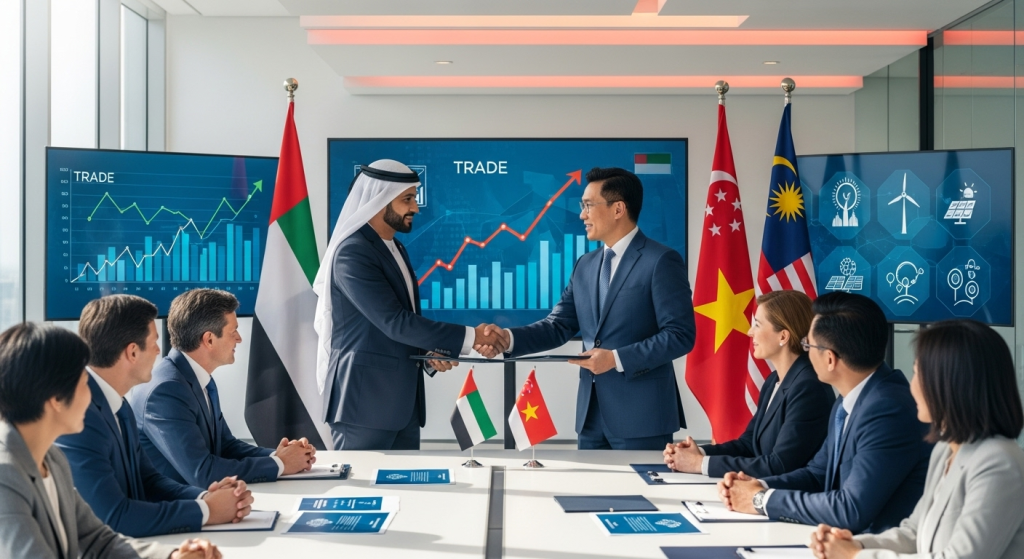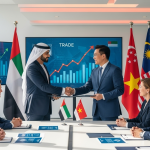Introduction
The United Arab Emirates (UAE) has recently made significant strides in enhancing its economic relationships with Southeast Asia through a series of new trade agreements. These agreements aim to bolster bilateral trade, attract investment, and facilitate business expansion in the region. As the UAE continues to diversify its economy, these developments are pivotal in positioning the nation as a key player in the global market.
Overview of the Trade Agreements
In the past few months, the UAE has signed multiple trade agreements with several Southeast Asian nations, including Indonesia, Malaysia, and Vietnam. These agreements focus on reducing tariffs, simplifying trade regulations, and fostering cooperation in various sectors, including technology, agriculture, and renewable energy.
Key Features of the Agreements
1. **Tariff Reductions**: The agreements include provisions for reducing or eliminating tariffs on a wide range of goods, making it easier for businesses to trade between the UAE and Southeast Asia.
2. **Investment Protection**: The agreements provide frameworks for protecting investments, ensuring that businesses can operate with confidence in foreign markets.
3. **Sectoral Cooperation**: Specific sectors have been identified for cooperation, including technology transfer, agricultural products, and renewable energy initiatives.
4. **Joint Ventures**: The agreements encourage joint ventures between UAE and Southeast Asian companies, fostering innovation and shared growth.
Impact on Bilateral Trade
The impact of these agreements on bilateral trade is expected to be substantial. According to recent statistics, trade between the UAE and Southeast Asia has already seen a significant increase, with exports and imports growing by over 20% in the last year alone. This upward trend is anticipated to continue as businesses take advantage of the new agreements.
Benefits for UAE Businesses
– **Access to New Markets**: UAE businesses will gain easier access to the rapidly growing markets of Southeast Asia, which has a combined population of over 650 million.
– **Diversification of Trade Partners**: By expanding trade relationships beyond traditional partners, UAE businesses can reduce their reliance on specific markets and enhance their resilience.
– **Increased Competitiveness**: With reduced tariffs and improved trade conditions, UAE businesses can offer more competitive pricing for their products in Southeast Asian markets.
Sectoral Opportunities
The trade agreements open new avenues for various sectors within the UAE. Here are some key sectors poised for growth:
1. Technology
The technology sector stands to benefit significantly from these agreements. Collaboration in areas such as artificial intelligence, cybersecurity, and e-commerce can lead to innovative solutions tailored for both markets. The UAE’s investment in technology infrastructure, combined with Southeast Asia’s growing tech landscape, creates a fertile ground for partnerships.
2. Agriculture
Southeast Asia is known for its agricultural products, and the UAE’s agreements aim to enhance food security through increased imports of fruits, vegetables, and other agricultural goods. This partnership can also lead to knowledge exchange in sustainable farming practices and agricultural technology.
3. Renewable Energy
As the UAE continues to invest in renewable energy, partnerships with Southeast Asian countries can lead to joint projects in solar and wind energy. These collaborations can help both regions meet their sustainability goals while creating jobs and driving economic growth.
Challenges and Considerations
While the new trade agreements present numerous opportunities, there are challenges that businesses must navigate:
1. Regulatory Differences
Each Southeast Asian country has its own regulatory framework, which can pose challenges for UAE businesses looking to enter these markets. Understanding local laws and regulations will be crucial for successful market entry.
2. Cultural Differences
Cultural nuances can impact business negotiations and operations. UAE businesses must invest in understanding the local culture to build strong relationships and effectively communicate with partners.
3. Logistics and Supply Chain
Efficient logistics and supply chain management will be vital to capitalize on the new trade agreements. Businesses must ensure they have reliable transportation and distribution networks in place to meet demand.
Conclusion
The UAE’s new trade agreements with Southeast Asian nations mark a significant step forward in enhancing economic ties and fostering growth. By reducing barriers to trade and encouraging collaboration across various sectors, these agreements are set to create a wealth of opportunities for businesses in both regions. As the UAE continues to diversify its economy and strengthen its global position, the focus on Southeast Asia will likely play a crucial role in its long-term economic strategy.
For more information on investment opportunities and business setup in the UAE, visit Persian Horizon.
Source and Publication Date
Source: Gulf News
Publication Date: 2023-10-15
Source: https://gulfnews.com/uae








